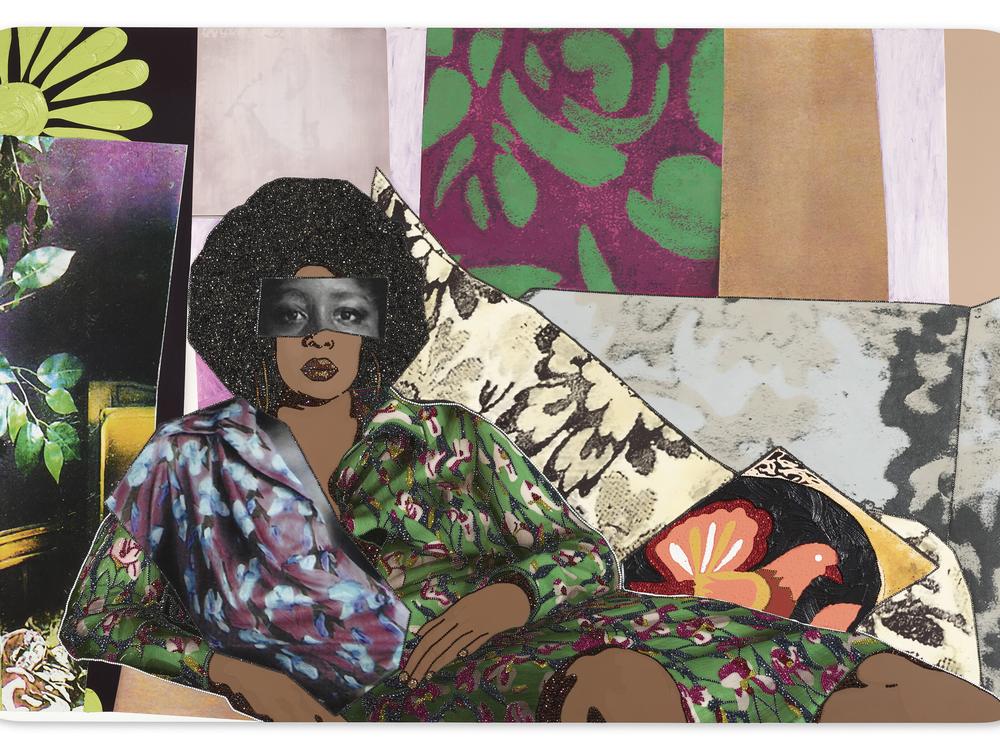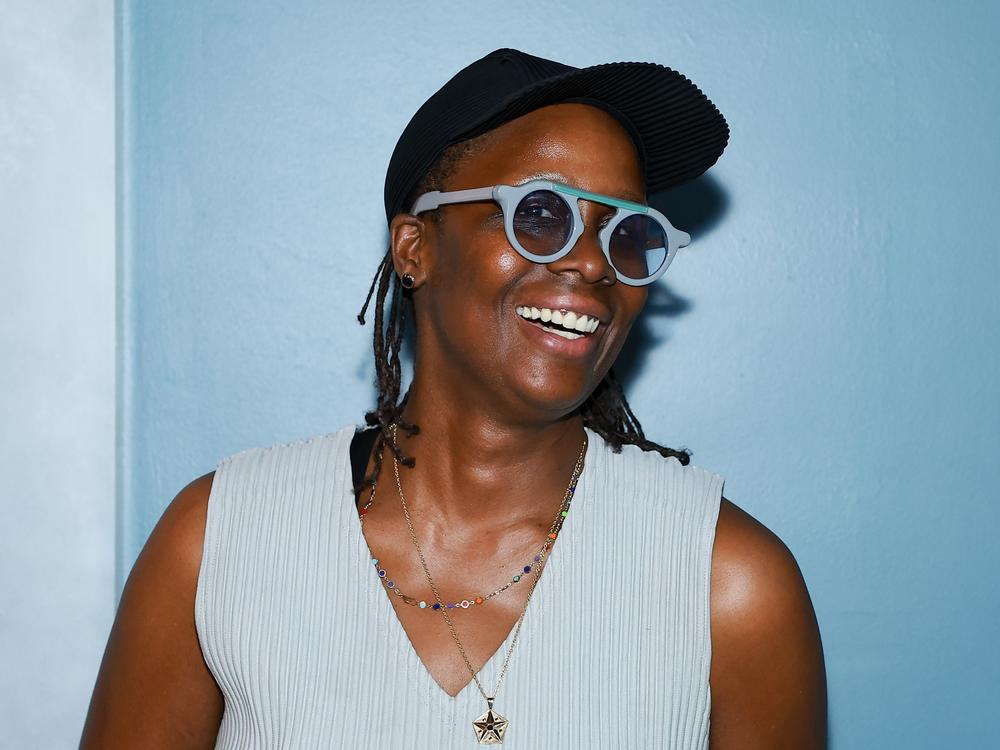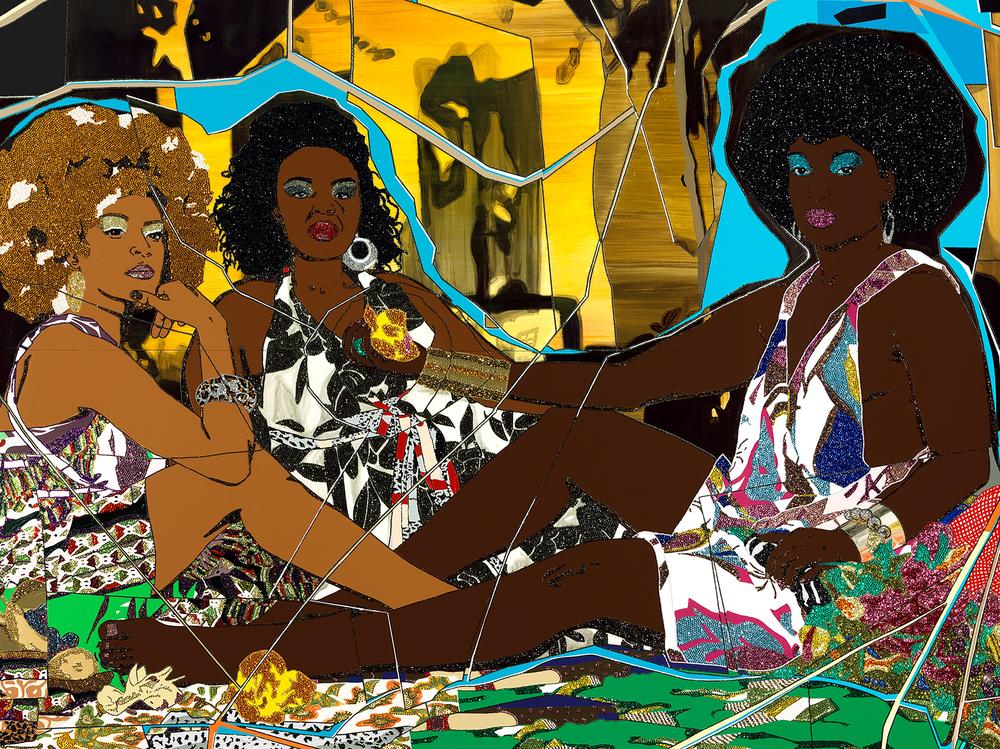Section Branding
Header Content
Mickalene Thomas makes art that 'gives Black women their flowers'
Primary Content
In Mickalene Thomas' art work, Black women are front and center. Her subjects are often at leisure, resting on couches and chairs, sometimes nude, and frequently accentuated by rhinestones and rich colorful patterns.
"I would describe my art as radically shifting notions of beauty by claiming space," she says. "We've been supportive characters for far too long and … my art gives Black women their flowers and lets them know that they are the leading role."
The scale of Thomas' paintings, often made of unconventional materials like glitter, sequins, and yarn, makes them feel larger than life, with the eyes of her subjects gazing directly at the viewer. Each piece begins as a collage.
"I love the instant, tangible way having my hands at it, as if I'm sculpting with the paper, allows me the immediacy of the process," she says. "My scissors are sort of a way of drawing."
Thomas often recasts scenes from 19th-century French paintings, centering Black sensuality and power. She says her ultimate goal is to celebrate the "sisterhood" that exists between Black women, and which she grew up experiencing.
"The trials and tribulations of my own life as a child did not negate the fact that there was a lot to love and care and family and support and comfort, even when there was struggle," she says. "So that's what I bring forth in my work."
Thomas' latest exhibition, "All About Love," is midway through an international tour with stops in Los Angeles, Philadelphia (The Barnes Foundation, through Jan. 12, 2025), London and France. The Barnes exhibition features 50 paintings, collages, and photography spanning over two decades, inspired by the women in her life, including her mother, who died in 2012.
Interview highlights
On her 2010 reinterpretation of Manet's "Le Déjeuner sur l'herbe"
I decided to reinterpret or reclaim this space [by depicting] … three powerful women who are fully clothed, seated and not at a picnic, just lounging and giving each other their flowers.
On finding a home in art
I think that art has saved my life, for sure. Growing up, going to after school programs at the Newark Museum, it was, for me, this safe haven, this comfort, this refuge. I loved going there after school. I loved doing all the craft projects, the papier-mâché, exploring different ways of making self-portraits or building houses with popsicle sticks and all those things. … It was just an outlet, a way of expressing myself, but also a place to go after school until my mother got off work.
On using inexpensive craft supplies
When I was in Pratt, I couldn't afford oil paint. I would rummage, often through the recycled stretcher bins, and gather my materials from that. And all I could afford was craft materials because they were cheaper than oil paint, like felt and different fabrics, glitter. … So I gravitated towards those materials because they were accessible and affordable for me. But what they did was open up a way of expressing myself. … There was a struggle of completing some assignments because some you had to use oil paint or some you had to use the traditional materials. … Sometimes people [would] throw away tubes of paint because they think it's [finished] and [I'd] just cut it open, [and] there's still paint in there.
[Now] I love using the high-end material and still the acrylic. I use both. But now I mix them up. And so you can't tell what's high or low, but that's just part of life sometimes, right? You can wear H&M with a Prada jacket and still look fabulous. … Sometimes things that are so simplistic and that cost nothing are so much more rewarding.
On her late mother's support of her work
She got to see it, experience it, celebrate it. She was celebrated for it. She was admired and adored. She loved the fact that she was a part of my art. She loved coming to the openings. She loved coming to my friends' openings. She loved supporting my community. So whether it was my opening or one of my artist friends', she would show up. And so I love that about her. She was a great advocate. She's always been an advocate for the arts. She always supported that. When I decided I wanted to be an artist, she never looked at it as, "Why you want to go and do that?" Some of those things were in my head, but she never vocalized that. She was supportive.
Ann Marie Baldonado and Susan Nyakundi produced and edited this interview for broadcast. Bridget Bentz, Molly Seavy-Nesper and Beth Novey adapted it for the web.



